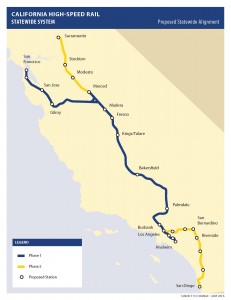 The California High Speed Rail Authority has been battered not just by Republicans in Congress but by the state’s primary environmental law, the California Environmental Quality Act (CEQA). The law requires environmental review of projects before they commence.
The California High Speed Rail Authority has been battered not just by Republicans in Congress but by the state’s primary environmental law, the California Environmental Quality Act (CEQA). The law requires environmental review of projects before they commence.
While that sounds sensible in concept, in practice CEQA has opened the authority up to lawsuits and delay from opponents up and down the route, from wealthy homeowners along the San Francisco peninsula to farmers along the San Joaquin Valley route who don’t want their properties bisected by the rail line.
The impact on the project from CEQA has been increased costs, delay, and in my view a less-effective route for the rail line (of course blame primarily rests on the politicians who gerrymandered the route in the first place, but due to CEQA it’s now impossible to correct the route without opening up the process all over again and inviting even more lawsuits).
While most people can agree that the agency should mitigate impacts where feasible and study these impacts in advance, CEQA lawsuits have instead served to drag out the high speed rail planning process and drive up costs. These effects undermine a project that is actually critical to long-term environmental goals, let alone economic goals related to mobility.
So it’s perhaps not surprising that the High Speed Rail Authority would love to escape the jurisdiction of CEQA. And that’s precisely the issue in today’s California Supreme Court argument in Friends of the Eel River v. North Coast Railroad Authority, Nos. S222472. This case actually involves a different rail line in California’s north coast, but the rail operator makes the same argument as the High Speed Rail Authority that CEQA doesn’t apply, due to federal rail law preemption of state law.
As my colleague Rick Frank summarized on Legal Planet:
This case raises the issue of whether federal law–specifically, the Interstate Commerce Commission Termination Act (ICCTA)–preempts the application of CEQA to a state-owned and funded rail line on California’s North Coast. Lower state courts have split on that issue, which has consequences far beyond the proposal to reactivate this previously dormant railroad line. For example, the same legal issue is raised in a federal case currently pending in the U.S. Court of Appeals for the Ninth Circuit involving California’s High Speed Rail Authority. In that federal appeal, the federal Surface Transportation Board–an obscure but important federal agency charged with implementing the ICCTA–notified the High Speed Rail Authority that it considers CEQA’s application to the planning and construction of California’s controversial High Speed Rail system to be preempted by the ICCTA. (Kings County v. Surface Transportation Board, Ninth Circuit No. 15-71780.) So the potential exists for conflicting rulings from the California Supreme Court and Ninth Circuit on the CEQA preemption question that would require the U.S. Supreme Court to resolve the issue. Additionally, the same preemption argument has regularly been made by oil and railroad companies who seek to ship crude oil by rail through California cities that oppose such oil shipments as unduly hazardous.
I listened to the oral argument today on-line (and I also had the opportunity to participate in a moot court last week for the plaintiffs). Based on the questions I heard from the justices, my guess is that the Supreme Court will find CEQA to be not preempted by federal law and therefore require the rail agency to enforce CEQA review.
But it’s a tough case. CEQA is open-ended by its nature, and the delays and mitigation measures that follow are likely to interfere with rail operations, which is precisely what federal law seeks to preempt. But it’s hard to imagine a state court voluntarily writing away its own state law. Instead, I would guess that the justices will frame the decision as allowing CEQA review in a limited fashion, given existing legal restraints from federal law.
But with the federal Ninth Circuit case pending on the same issue (this time explicitly involving high speed rail), we could very well end up with a split that will need to be resolved at the U.S. Supreme Court. So regardless of the outcome of this case, we’re likely to see more action to come on this question.


